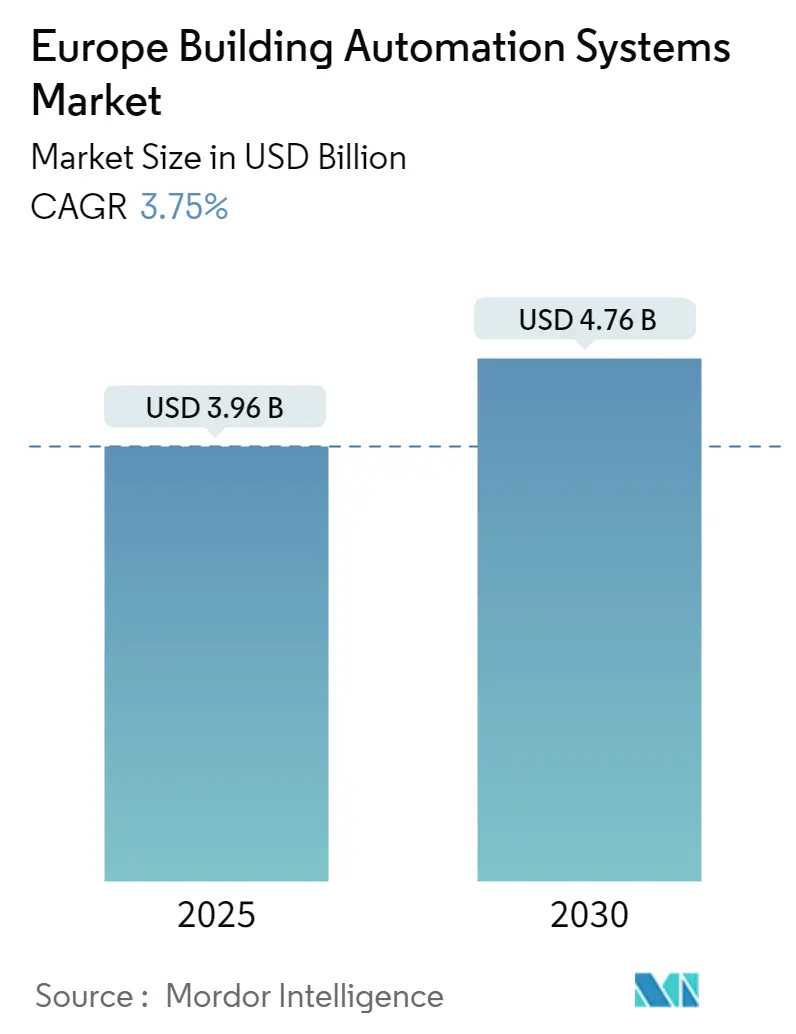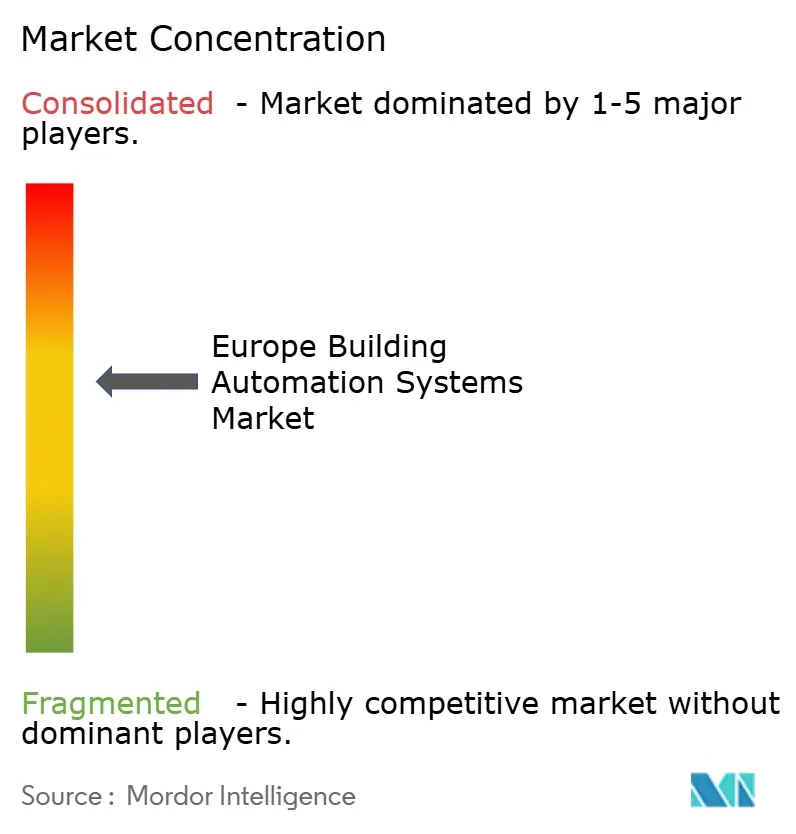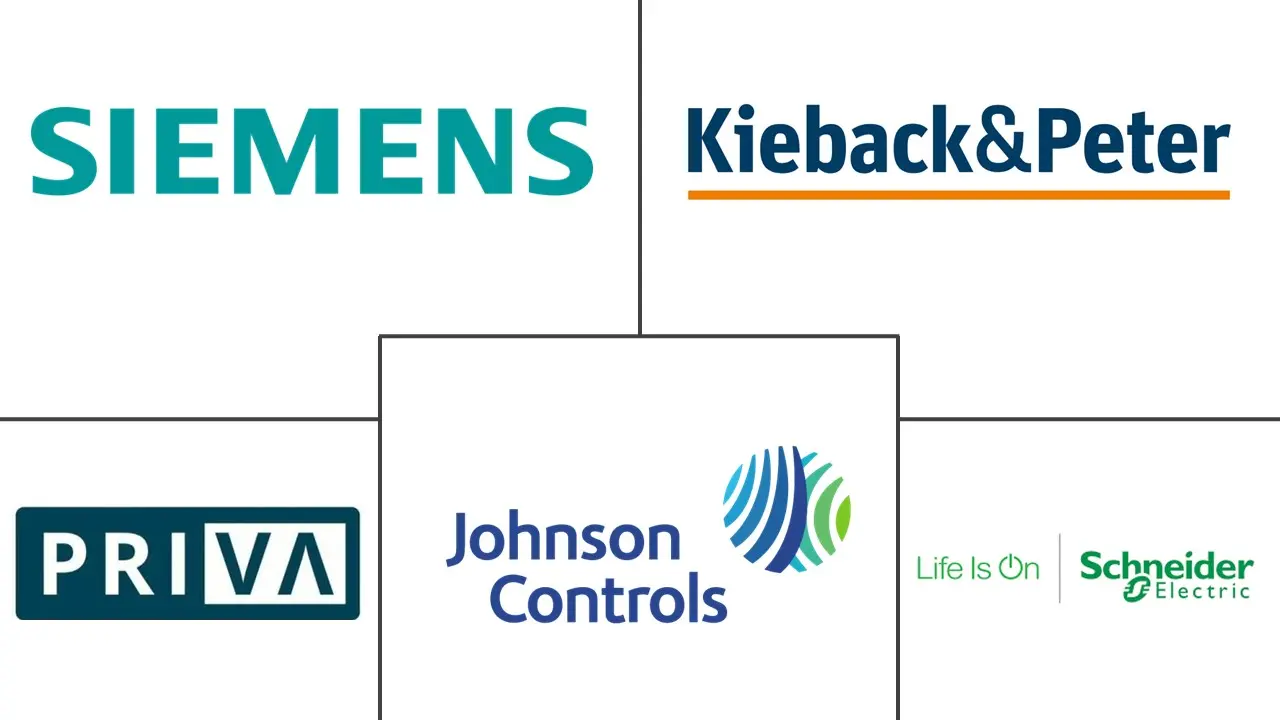
Europe Building Automation Systems Market Analysis by Mordor Intelligence
The Europe Building Automation Systems market size stood at USD 3.96 billion in 2025 and is projected to reach USD 4.76 billion by 2030, registering a 3.75% CAGR during 2025-2030.[1]Siemens AG, “Siemens AG Financial Results Q1 2025,” siemens.com Growing compliance obligations under the revised Energy Performance of Buildings Directive, rising electricity prices, and corporate net-zero targets guide most investment decisions. Retrofit opportunities dominate because three-quarters of the region’s building stock predates 1990, yet innovation centers on cloud-enabled analytics, wireless sensors, and AI-driven optimization. Hardware remains the revenue anchor while Software-as-a-Service introduces recurring income streams and shortens payback periods for mid-sized property portfolios. Competition is moderate: a handful of global manufacturers supply core controllers and field devices, but hundreds of regional integrators shape delivery schedules, project costs, and user training outcomes. Persistent labour bottlenecks and cybersecurity liabilities act as near-term brakes on project velocity, although product standardization and ecosystem partnerships are gradually reducing risk perceptions.
Key Report Takeaways
- By component, hardware accounted for 66.13% of Europe Building Automation Systems market share in 2024. By component, Software-as-a-Service is forecast to expand at a 6.11% CAGR through 2030.
- By end user, commercial buildings commanded 45.44% share of the Europe Building Automation Systems market size in 2024. By end user, residential applications are advancing at a 5.63% CAGR through 2030.
- By building life cycle, retrofit projects controlled 71.35% share in 2024. By building a life cycle, new-build deployments are projected to grow at 4.92% CAGR between 2025-2030.
- By communication protocol, BACnet held 41.26% of Europe Building Automation Systems market share in 2024. By communication protocol, KNX IoT is poised to rise at 6.40% CAGR through 2030.
Europe Building Automation Systems Market Trends and Insights
Drivers Impact Analysis
| Driver | (~) % Impact on CAGR Forecast | Geographic Relevance | Impact Timeline |
|---|---|---|---|
| Mandatory BACS in EPBD revision | +1.20% | EU-wide, strongest in Germany, France, Netherlands | Medium term (2-4 years) |
| Rapid fall in wireless sensor prices | +0.80% | Global, accelerated adoption in Nordic countries | Short term (≤ 2 years) |
| Corporate net-zero commitments | +0.90% | Western Europe, multinational headquarters | Long term (≥ 4 years) |
| Edge-AI analytics boosting OPEX savings | +0.70% | Commercial hubs: Germany, UK, France | Medium term (2-4 years) |
| Increasing smart-home retrofits | +0.50% | Northern Europe, high-income urban areas | Long term (≥ 4 years) |
| ESG-linked financing incentives | +0.40% | EU core markets, institutional real estate | Medium term (2-4 years) |
| Source: Mordor Intelligence | |||
Mandatory BACS in EPBD revision
The 2025 enforcement of the revised Energy Performance of Buildings Directive obliges non-residential facilities above 290 kW heating load to deploy interoperable automation and control systems. Germany and France adopted even stricter thresholds, accelerating tender activity across public offices, schools, and healthcare sites.[2]European Commission, “Revision of the Energy Performance of Buildings Directive,” ec.europa.eu Open-protocol solutions such as BACnet and KNX receive preferential treatment in grant programs, prompting building owners to replace proprietary networks during planned renovations. Compliance deadlines cluster around 2027, creating pronounced peaks in engineering demand and sparking specialized training initiatives. Enforcement rigor differs by member state, yet the overall mandate locks Europe Building Automation Systems market growth into regulatory timetables. Vendors with local installation partners and multilingual commissioning software gain a visible competitive edge.
Rapid fall in wireless sensor prices
Average selling prices of multi-technology occupancy, temperature, and light sensors dropped by nearly 30% between 2023 and 2025, mainly because of higher 200 mm wafer output in East Asia and a transition to system-on-chip architectures. Nordic property owners were early adopters, using battery-powered sensors to monitor energy-intensive facilities during prolonged heating seasons. Reduced wiring and ceiling core-drilling costs shorten payback periods on small projects, broadening the customer base beyond A-grade office towers. Edge-processing features embedded inside new chips lower latency, screen false positives, and retain sensitive building usage data inside the premises, supporting GDPR compliance. Although component prices are now less volatile than during the 2021-2022 supply crunch, occasional shortages of specialized RF microcontrollers still trigger modest lead-time spikes for integrators.
Corporate net-zero commitments
Global corporations headquartered in London, Frankfurt, and Paris align their building portfolios with the EU Taxonomy, demanding verifiable carbon-reduction pathways. Real-time energy dashboards and automated fault detection modules form the backbone of carbon accounting, driving multi-site rollouts of standardized BAS architectures. Johnson Controls reported a record USD 13.2 billion building-solutions backlog in 2025, underpinned by data-center cooling upgrades that directly reduce Scope 2 emissions.[3]Johnson Controls, “Record Building Solutions Backlog,” securitysystemsnews.com Lenders now embed step-down interest rates in green loans when energy-use-intensity targets are met, effectively subsidizing automation investments. Over the next decade, the Europe Building Automation Systems market is set to capture incremental demand as ESG reporting converges with operational cost savings.
Edge-AI analytics boosting OPEX savings
Schneider Electric logged field studies showing 15-20% HVAC energy savings when model-predictive control runs inside local controllers rather than in a remote cloud. Honeywell opened a Netherlands R&D hub devoted to edge-learning algorithms that coordinate thermal load with photovoltaic generation.[4]Honeywell International, “Netherlands Edge-AI Center Press Release,” facilitiesdive.com Improved autonomy frees facility teams from manual overrides and responds instantly to occupancy fluctuations, boosting tenant comfort indices. Cybersecurity risk is mitigated because raw data remains behind the firewall, and only summary KPIs move to corporate servers. Solutions priced on energy-savings-sharing agreements lower capex barriers for mid-sized landlords. As algorithms mature, predictive maintenance functions help postpone chiller overhauls, prolonging asset life and strengthening vendor service revenues.
Restraints Impact Analysis
| Restraint | (~) % Impact on CAGR Forecast | Geographic Relevance | Impact Timeline |
|---|---|---|---|
| Fragmented legacy building stock | -0.60% | Western Europe, historic city centers | Long term (≥ 4 years) |
| Cyber-security liability concerns | -0.40% | EU-wide, critical infrastructure focus | Medium term (2-4 years) |
| Vendor-specific protocol lock-in | -0.30% | Mixed across regions | Medium term (2-4 years) |
| Skilled-labour bottlenecks | -0.50% | Germany, Netherlands, Nordic countries | Short term (≤ 2 years) |
| Source: Mordor Intelligence | |||
Fragmented legacy building stock
Historic masonry structures in Paris, Rome, and Barcelona often prohibit core drilling or heavy conduit runs, complicating sensor placement and cabling. Mixed-era mechanical plant — from radiators to variable-air-volume boxes — requires meticulous interface mapping, elevating engineering hours and contingency budgets. Owners sometimes postpone deep automation until major tenancy turnovers, prolonging decision cycles beyond conventional fiscal years. Regional craft guilds enforce preservation norms, curbing invasive retrofits. Consequently, integrators invest in wireless, battery-free actuators and reversible mounting kits that comply with heritage guidelines, yet these specialized components carry price premiums that shrink return-on-investment windows.
Cyber-security liability concerns
Expanded attack surfaces emerge as building networks interconnect elevators, lighting, and access control. Insurers increasingly request proof of ISO 27001 controls before underwriting large commercial properties. Breaches could expose tenant personal data, triggering hefty GDPR fines. The European Union Agency for Cybersecurity promotes baseline requirements, but varying adoption speeds sow confusion among building owners, delaying purchase orders. Vendors respond with secure-boot controllers and encrypted L2 protocols, but full remediation of legacy equipment is costly, feeding board-level reluctance to green-light comprehensive upgrades.
Segment Analysis
By Component: Hardware dominance and SaaS acceleration
Hardware captured 66.13% of 2024 revenue as reliable controllers, actuators, and multi-standard gateways underpin every functional layer of the Europe Building Automation Systems market size. Controllers routinely manage thousands of I/O points, pushing suppliers to refine real-time processing and cyber-hardening. In parallel, sensors migrate to ultra-low-power wireless chips, broadening retrofit feasibility inside pre-1910 buildings where cable trays are scarce.
Cloud-hosted analytics and remote firmware updates explain the 6.11% CAGR in SaaS subscriptions. Building owners favour operating expenses over capital outlays, purchasing AI-based optimization features on rolling contracts. Predictable billing eases budget planning and encourages continuous scope expansion—once a building’s HVAC loops are online, lighting, security, and EV-charger modules follow swiftly. Vendors integrate edge-AI inference capabilities into room controllers, shifting computation away from hyperscale data centers and satisfying regional data-sovereignty laws.

By End User: Commercial leadership with residential momentum
Commercial premises held 45.44% of Europe Building Automation Systems market share in 2024, spurred by mandatory energy audits and competitive tenant landscapes. Facility managers prioritize thermal comfort and indoor-air-quality dashboards to attract occupants in hybrid-work environments. Hospitals upgrade critical zones for negative pressure control, whereas the retail sector deploys AI-based refrigeration monitoring to reduce spoilage.
Residential demand grows at a 5.63% CAGR through 2030, catalysed by smart-meter rebates and national electrification incentives. Multi-family dwellings adopt centralized plant control to allocate utility costs precisely, while detached homes lean toward voice-activated scenes and utility-driven demand-response widgets. Despite fewer per-unit points, aggregate household volumes rival small commercial footprints, prompting consumer-electronics brands to forge alliances with traditional BAS suppliers.
By Building Lifecycle: Retrofit dominance drives innovation
Retrofits represented 71.35% of Europe Building Automation Systems market share in 2024. Wireless sensors, stick-on actuators, and self-commissioning dashboards minimize tenant disruption and shorten project schedules in occupancy-dense real estate. Manufacturers market gateway appliances that translate legacy bus signals into BACnet IP, preserving functional investment while opening a pathway to advanced analytics.
New-build projects show the fastest 4.92% CAGR, aided by integrated design processes where mechanical, electrical, and BAS teams collaborate from concept. Digital twins created during construction migrate into facility-management platforms at handover, eliminating duplication and enabling predictive maintenance on day one. Mass-timber and modular-housing initiatives incorporate prefabricated sensor harnesses, reducing time on site and standardizing device counts per square meter.

By Communication Protocol: BACnet stability meets KNX IoT innovation
BACnet’s 41.26% foothold derives from decades of multi-vendor interoperability in large campuses and airports. Its object-oriented data models simplify graphics libraries and alarm routing, cutting engineering hours in complex projects. Cybersecurity addenda (BACnet/SC) join TLS encryption to allay rising risk concerns.
KNX IoT grows at a 6.40% CAGR by coupling IPv6 addressing with established twisted-pair reliability. Open REST APIs invite third-party app developers to mine building data for ESG dashboards. Market entrants’ bundle KNX sensor packages with cloud subscription tiers, allowing small offices to pilot analytics without forklift upgrades. Industrial heritage protocols like Modbus retain pockets of critical-process control but yield incremental share as property owners pursue firmware uniformity across asset types.
Geography Analysis
Germany leads in absolute project value, driven by stringent regional energy codes and a 35% rise in heat-pump installations during Q1 2025. Big-ticket campuses in Frankfurt’s financial district and Bavaria’s automotive belt adopt campus-wide supervisory controls that integrate on-site solar arrays and battery storage. Labor shortages, however, stretch commissioning timelines, nudging owners to prefabricated control cabinets and remote factory acceptance testing.
The United Kingdom and France follow, albeit with diverging triggers. British landlords tap green-lease clauses to pass retrofit costs onto tenants while leveraging low-carbon property tax reliefs. French municipalities roll out time-bound incentives tied to EPBD milestones, crowding contractor schedules. Both markets prefer retrofit approaches; Victorian brick shells in London and Haussmann façades in Paris hamper invasive cabling, propelling mesh-network sensor deployments.
Nordic countries display the highest per-capita penetration, compelled by heating-intensity climates and grid-balancing policies that pay buildings for demand-response participation. Sweden pioneers district-heating integration where BAS controllers exchange load data with utility SCADA in 5-minute intervals. Southern European nations such as Spain and Italy accelerate mainly because of steep electricity tariffs post-2023, though fragmented ownership patterns and older HVAC equipment temper growth. Eastern Europe, buoyed by EU cohesion funds, constitutes the market’s frontier: new-build logistics parks near Warsaw and Prague embed BACnet IP from the ground up, showcasing regional convergence toward pan-European standards.
Competitive Landscape
The Europe Building Automation Systems market leans toward moderate consolidation: the top five suppliers accounted for roughly 55% of 2024 revenue. Siemens capitalizes on domestic manufacturing and exports project know-how to neighbouring countries. Johnson Controls extends service contracts beyond standard warranties, bolstering margins through predictive-maintenance subscriptions. Schneider Electric’s EcoStruxure platform interoperates with low-voltage switchgear and EV chargers, broadening wallet share within each facility. Honeywell offsets industrial automation softness by channelling R&D dollars into edge-analytics firmware that unlocks recurring SaaS income.
Regional specialists thrive in niches: Belimo rules damper actuators, Sauter curates’ supervisory software for Swiss municipalities, and Kieback & Peter tailors gateways for heritage buildings. Start-ups infiltrate wireless sensor arrays, offering ten-year battery life and Bluetooth-direct commissioning. Cyber-security firms enter the stack through zero-trust gateways that wrap legacy BACnet traffic in AES-encrypted tunnels, a growing differentiation lever in tender documents.
M&A activity centers on analytics and sustainability reporting: Johnson Controls paid USD 450 million for a European AI-optimization house, aiming to halve implementation timelines in multi-site rollouts. Private-equity investors circle mid-tier integrators lacking succession plans, seeking to consolidate fragmented installation capacity and exploit economies of scale in training and procurement.
Europe Building Automation Systems Industry Leaders
-
Siemens AG
-
Johnson Controls International PLC
-
Kieback&Peter GmbH & Co. KG
-
Priva Holding BV
-
Schneider Electric SE
- *Disclaimer: Major Players sorted in no particular order

Recent Industry Developments
- May 2025: Siemens announced a EUR 2.1 billion investment in smart-building plants in Germany and Poland to localize controller production and ease supply-chain risks.
- February 2025: Johnson Controls acquired an analytics firm for USD 450 million to enhance predictive-maintenance modules.
- January 2025: Schneider Electric launched SF6-free medium-voltage switchgear in France, aligning with EU fluorinated-gas bans.
- December 2025: ABB won a USD 280 million contract to automate 15 European airports, integrating lighting, HVAC, and security under a single dashboard.
Europe Building Automation Systems Market Report Scope
Building automation systems exhibit functions such as control of the building's environment, operating systems depending on the energy need, and monitoring the system enactment, based on which the systems produce sound alerts as needed. It centrally controls the building's heating, ventilation, air conditioning (HVAC), electrical, access control, and other interrelated systems.
The European building automation systems market is segmented by component (hardware [controllers and field devices] and software-as-a-service), end user (residential, commercial, and industrial), and country (Germany, United Kingdom, France, Spain, Italy, and Rest of Europe). The report offers the market size and forecasts for all the above segments in value (USD).
| Hardware | Controllers |
| Field Devices | |
| Software-as-a-Service |
| Residential |
| Commercial |
| Industrial |
| New-build |
| Retrofit |
| BACnet |
| KNX (Classic and IoT) |
| Modbus / LonWorks |
| Germany |
| United Kingdom |
| France |
| Spain |
| Italy |
| Netherlands |
| Belgium |
| Sweden |
| Finland |
| Denmark |
| By Component | Hardware | Controllers |
| Field Devices | ||
| Software-as-a-Service | ||
| By End User | Residential | |
| Commercial | ||
| Industrial | ||
| By Building Life-Cycle | New-build | |
| Retrofit | ||
| By Communication Protocol | BACnet | |
| KNX (Classic and IoT) | ||
| Modbus / LonWorks | ||
| By Geography | Germany | |
| United Kingdom | ||
| France | ||
| Spain | ||
| Italy | ||
| Netherlands | ||
| Belgium | ||
| Sweden | ||
| Finland | ||
| Denmark |
Key Questions Answered in the Report
What is the current value of the Europe Building Automation Systems market?
It was valued at USD 3.96 billion in 2025.
How fast is the market expected to grow by 2030?
The forecast CAGR is 3.75% from 2025 to 2030.
Which component segment is expanding the quickest?
Software-as-a-Service is projected to grow at 6.11% CAGR through 2030.
Why are retrofits so dominant in the region?
Nearly 71% of buildings are older structures requiring energy-efficiency upgrades rather than new construction.
Which protocol is gaining the most traction after BACnet?
KNX IoT is advancing at a 6.40% CAGR because it combines IP connectivity with field-level reliability.
What primary risk slows deployment?
Cyber-security liability concerns delay investment decisions, especially in critical-infrastructure properties.
Page last updated on:



